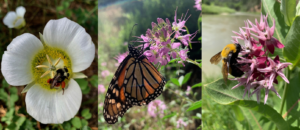
New Mexico Wild Celebrates BLM Decision To Halt Aerial Spraying of Toxic Insecticides Over Rio Chama Watershed
Media Contact:
Bjorn Fredrickson, New Mexico Wild, bjorn@nmwild.org, (206) 372-5608
Taos, NM (June 29, 2023)– Today, New Mexico Wild and thousands of our members celebrate and thank Pamela Mathis, BLM Taos Field Office Manager, for her decision to deny a proposal by USDA Animal and Plant Health Inspection Service (APHIS) to spray the toxic insecticide carbaryl over nearly 40 square miles of federal public lands in New Mexico. APHIS had proposed to spray this area as early as June 26th due to the potential loss of forage for cattle should native grasshopper and cricket species swarm.
The proposed spray area that would be directly impacted was comprised mostly of federal public lands managed by the Bureau of Land Management (BLM), including a Wilderness Study Area and an Area of Critical Environmental Concern. It was also located in close proximity to other designated areas, including the Chama River Canyon Wilderness and the Rio Chama Wild and Scenic River, as well as the Jicarilla Apache Nation. These additional lands near the project area would have also likely been impacted by this ill-conceived operation due to insecticide misapplication, drift, and migration due to runoff during a monsoonal event.
Carbaryl is a highly toxic insecticide that would have decimated local insect pollinator populations at the height of a crucial wildflower blooming period and posed a threat to multiple species listed under the Endangered Species Act, including the New Mexico meadow jumping mouse, Mexican spotted owl, and Southwestern willow flycatcher. APHIS has acknowledged the toxicity of carbaryl to non-target pollinators, fish and wildlife, and humans. The EPA has also determined that carbaryl is likely carcinogenic to humans, and exposure to carbaryl can cause nausea, headaches, dizziness, anxiety, mental confusion, convulsions, coma, and death.
To demonstrate widespread opposition to this proposed operation, New Mexico Wild coordinated and sent a sign-on letter with 28 signatures from New Mexican conservation, business, Tribal, agricultural, and community leaders to Field Manager Mathis, New Mexico APHIS leadership, and to New Mexico’s Congressional delegation. We also developed a petition signed by 2,460 people in under 48 hours, which demonstrates vocal and broad-based public opposition to this proposal.
“As many New Mexicans know, the public lands within the Rio Chama watershed are treasured for their ecological, cultural, scenic, and recreational values. We are grateful that the BLM made the responsible decision to reject the reckless proposal to conduct aerial spraying of carbaryl, an especially toxic pesticide, in this sensitive location without adequate environmental review or public notice,” said Sally Paez, Staff Attorney for New Mexico Wild. “Going forward, we urge APHIS and our public land management agencies to consider less harmful alternatives to supporting grazing on public lands. If highly impactful projects such as this must be considered in the future, they must be subject to rigorous environmental analysis and a transparent public process to avoid devastating unintended consequences.”
The denial of this specific proposal, while absolutely justified, does not mean that similar operations will not be proposed in the future. The ability of APHIS to propose and undertake broad-based aerial spraying of toxic insecticides demonstrates a need for pesticide reform at the state and federal levels. New Mexico Wild will remain vigilant in monitoring for similar proposals that would impact federal public lands in the future and will immediately work to mobilize partner organizations, community leaders, and the public in opposing proposed aerial insecticide applications.
###
Read the BLM’s press release here.

